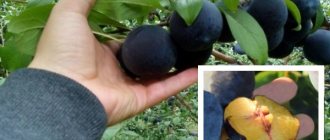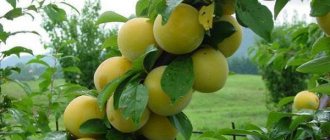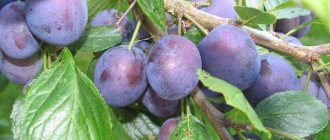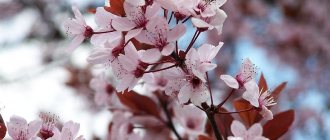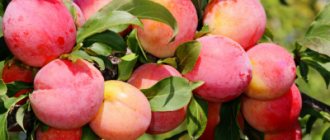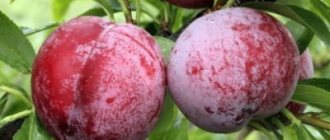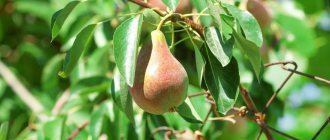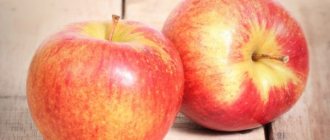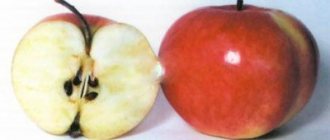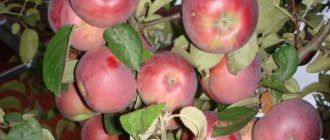Description of the variety Zarechnaya early
The tree is medium-sized .
The crown is not very thick, with weak foliage, shaped like a ball. Small gray lenticels are very noticeable on the crown. The buds are medium-sized , slightly pointed at the ends, and the adhesion to the shoots is weak.
The sheet is above average in size , with a matte surface, deep green in color.
The leaf blade is oval in shape with a pointed tip, almost flat. The leaf surface is leathery and smooth.
The glands are red, very small , 1–2 per leaf petiole. The petiole is strong , thick, of medium length, often with pigmentation. The petals of the flowers are white, medium-sized, touching each other.
The stamens are an order of magnitude shorter than the pistil. When the flowers are in the bud stage, they are green. The calyx of the flower is bell-shaped, greenish.
Photo
You can see the plum variety “Zarechnaya Rannyaya” in the photo below:
History of variety selection
Early ripening plums of the Zarechnaya rannyaya variety were obtained not long ago. In the second half of the 80s of the twentieth century, the variety was developed through selective crossing of three different plums. A year later, a derivation “formula” was obtained, which contained characteristics and notes from the observations of scientists. It was also already known how to care for it and when it is best to plant it. Zarechnaya plum in the second half of the 80s of the twentieth century was registered in the State Register by G. Kursakov as an early ripening variety. It was to the taste of many appraisers, and due to its properties, it grows in latitudes with a temperate climate. Homemade plum Zarechnaya early can withstand cold and heat, which makes it multifunctional for most garden owners and breeders.
Very often it can be found on the territory of the former Soviet republics and the Baltic states. Sometimes plums can be found in areas of central Siberia where summers are warm and winters are not very cold.
Features of the fruit
A distinctive feature of the variety are dark purple fruits , which are covered with a waxy coating. The size of plums is large , from 40 g to 50 g. The shape of the plum is round or oval-round. Subcutaneous points and the abdominal suture are clearly visible on the surface of the fetus.
Other plum varieties with large fruits are Svetlyachok, Vengerka Korneevskaya, Renklod Sovetskiy, Startovaya, Bolkhovchanka.
The fruits have a pleasant taste with a slight sourness. The pulp is dense , transparent yellow. Its structure is very juicy and tender, receiving a tasting rating of 4.5 points. The variety belongs to the table-technical variety .
Chemical composition:
- Dry matter – 16.83%;
- Sugar – 7.84%;
- Acid – 1.57%;
- Ascorbic acid – 3.5 mg/100g;
- P-active substances – 200 mg/100g.
Characteristics
The yield of this variety is very good . After planting, the tree begins to bear fruit in 3–4 years. The appearance of fruits begins early, towards the end of July. With each subsequent year there is an increase in the yield.
Frost resistance is high both in wood and in buds. Very unpretentious, tolerates any soil. Only very heavy clay soil can cause slight freezing of the roots, which will subsequently affect the yield.
Separability of the stone from the pulp is very good , which allows the fruit to be used in cooking and canning.
REFERENCE! The fruits have excellent transportability and shelf life, but for this they need to be removed from the branch 5–6 days ahead of schedule.
Advantages and disadvantages of the variety
- The advantages of the variety are:
- early fruiting;
- excellent taste of plums;
- good transportable properties;
- disease resistance;
- frost resistance.
The disadvantage can be considered the average yield, ineffective for industrial cultivation . But for a private garden, this becomes an advantage, since you get enough plums from one tree to meet your daily nutritional needs, and there is no need to worry about processing large volumes of produce.
Video: Zarechnaya early plum variety
Landing
Despite all the unpretentiousness of the plum, the young tree should be planted in the region for which the variety is zoned. This will ensure the best results in the future.
Plum loves sun and space . Even with slight shade, its fruits become smaller and the leaves turn yellow. Therefore, the landing site should be chosen in accordance with these requirements.
This crop is also wind intolerant . Strong gusts of wind can blow flowers, thereby depriving half of the harvest.
The best place to plant is next to the wall of a house or fence. It is also not suitable to plant plums in lowlands to avoid the accumulation of cold air.
Sandy loam and light porous loamy soils are considered the most favorable environment for growth The groundwater level should not be less than 2 meters from the ground surface. Otherwise, you can make small grooves to drain excess water.
REFERENCE! If there is sand or clay in the lower layers of the soil, then you should not plant plum trees on such soil.
Since “Zarechnaya Rannyaya” is a medium-sized tree, the distance between buildings or neighboring trees should be at least 4 meters.
Considering that the variety is zoned for the Black Earth Region, both autumn and spring may be a favorable time for planting . The hole for planting a tree should be prepared 2-3 weeks in advance. This is done so that the applied organic mineral fertilizers have time to settle.
The depth of the pit is 60 cm, the diameter is the same. Before planting a tree, you need to drive a stake into the middle of the hole, at an approximate distance of 15 cm from the seedling.
Basic landing rules :
- the pit is filled only with earth, without additional fertilizer;
- the root collar should be at least 2–5 cm above the ground;
- After planting, a small trench is made around the tree for effective watering.
Reviews from gardeners
Anatoly, Chernigov
The first harvest began in the second year after planting. No special care is needed, the main thing is to water it on time. It tolerates frost well; in the spring I cut off a few damaged shoots. Plums are juicy and sweet. My wife makes jams and preserves.
Maxim, Pskov
I planted it on the advice of my neighbors. I liked it - the fruits are sweet, juicy, can be stored for a long time and can withstand transportation. Suitable for preservation and fresh consumption.
Marina, Tambov
This is the sweetest plum in the garden. Plus the tree is beautiful and small. It provides good shade and children love to play under it. And in spring it blooms beautifully with white flowers. The crown is not dense, plus I am constantly shaping it. Therefore, harvesting is very convenient.
Care
After the tree is planted, it must be watered well. Three buckets are the optimal amount for one tree.
After two weeks, watering must be repeated. The exception is planting in spring. Given the high soil moisture after the snow melts, watering may be more moderate.
In order for the quality of the fruit to remain at the proper level, you need to monitor the growth of shoots , which grow very actively in the plum tree.
You need to remove unwanted layers several times a month. Remove diseased and dry branches, and also adjust the distance between the fruits, which should be at least 7 cm.
IMPORTANT! To regulate the frequency of fruiting, agronomists advise thinning the branches of the tree in a harvest year.
To prevent the branches from breaking under the weight of the fruit, the plum tree needs special supports to support the heavy branches. When choosing supports, it is important to eliminate friction between them with the bark. To avoid this, place a rag or rubber at the point of contact.
The tree does not need fertilizing in the first years after planting. You just need to water regularly. Watering is carried out once every 7–10 days. In the third year of a young tree’s life, you should start applying various fertilizers according to the following schedule :
- May – 2 tbsp. l. urea per 10 liters of water,
- June – 3 tbsp. l. nitrophoska per 10 liters of water,
- August – 2 tbsp. l. superphosphate per 10 liters of water.
How to propagate?
To save on purchasing seedlings, you can propagate the variety yourself. There are several ways to obtain a new crop.
Cuttings
For rooting, green cuttings 20-30 cm long are prepared in July. Planting material with 2-4 leaves is prepared from them and kept for 12-14 hours in water with the addition of a root growth stimulator.
Planted in the garden in a specially prepared soil mixture of peat and sand, fertilized with superphosphate. The distance between the cuttings should be at least 5 cm. A mini-greenhouse is formed using film and a wire frame. After 20-40 days, their root system will begin to form, then the shelter can be removed. In autumn, the bed is covered with a layer of mulch from peat and dry leaves; in harsh climates, spunbond is additionally used. In spring, the cuttings are transplanted to a permanent place.
Layering method
At the beginning of the season, the side shoot of the plum bends down to the ground and goes deep into a special trench. It is covered with earth, leaving the top of the head, about 20 cm long, outside. The layering is regularly watered to maintain a sufficient level of humidity, you can cover the trench with film. The appearance of green leaves at the top will indicate that the shoot has formed a root system. In the fall, the cuttings are separated and transplanted to another place.
Air layerings are obtained in the spring so that they can be rooted separately in the fall. To do this, select last year's shoot, make an incision at a height of 15-20 cm, fix the moistened fragnum in this place, and wrap it in film. If you keep the fragnum moist, roots will soon appear at the cut site. This part is separated and rooted into the ground along with the substrate for growing.
Trimming
Plum does not have a natural tendency to form a crown naturally, so it especially needs pruning. Typically, dry, diseased, and excess branches that interfere with access to sunlight are removed. Pruning is carried out in autumn or spring before sap flow begins.
REFERENCE! The greatest benefit will come from removing one large branch rather than several small ones.
When pruning, the length of the tree and the trunk must be adjusted.
It has been noticed that caring for compact trees is much easier than for tall ones. Their yield is better, and they tolerate severe frosts more easily.
Small trees are easier to harvest and sunlight penetrates every branch.
Harvest and storage
The taste of plums improves if they ripen on the tree . Press down on the fruit with your finger. The skin should be soft and the flesh elastic. The stalk of a ripe plum is easily separated from the branch. The collected fruits can be placed in a cool room and allowed to ripen.
Unfortunately, plums cannot be stored for long, so you will need to either eat or process the harvest. The best place to store plums is in the refrigerator. The best temperature is 0°C. Relative humidity is about 90–95%. The shelf life under these conditions is 2–4 weeks.
Diseases and pests
“Zarechnaya early” variety is quite resistant to diseases and is rarely attacked by pests. But preventive measures should still be observed.
The most common plum diseases are : bushiness, clasterosporiosis, moniliosis, gommosis, coccomycosis, rust, scab.
Pests that attack plum : hawthorn, fruit mite, aphid, plum moth, ringed silkworm.
To prevent disease, the following actions are recommended:
- Regularly inspect the tree for diseases.
- Timely cleaning and burning of fallen leaves under the tree.
- Thorough removal of weeds in the tree trunk circle.
- Spraying the tree in early spring with 3% Bordeaux mixture.
Measures to prevent damage to a tree by various parasites:
- Removing weeds and fallen leaves.
- Digging the soil in the tree trunk in the fall.
- Applying lime whitewash to the trunk.
- Spraying the tree with special products in early spring.
The Zarechnaya early plum is a very unpretentious, frost-resistant and easy-to-care variety. Its attractive fruits and lack of defects make the variety increasingly popular among gardeners.

